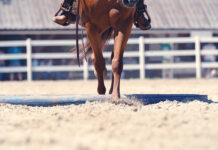To prepare for fly and mosquito season, target insects by eliminating or limiting their breeding grounds. Many insects proliferate around wet areas, such as bogs, ponds and mud. Mosquito larvae hatch in stagnant water that stands for four days, so drain containers and areas of standing water, refresh water in stock tanks, and clear away rotting vegetation and debris. Clean stalls and paddocks daily to remove other larval fly habitats, such as manure and urine-soaked bedding, and compost them to kill insect eggs and larvae.
- Contact your county agricultural agency about spraying ditches, creeks or ponds to kill mosquito larvae.
- Purchase fly sheets, fly masks and leg nets to protect your horses.
- Use roll-on repellent around eyes and ears, or a fly mask with ear covers.
- Aim fans at the stall to create sufficient air movement to deter flies.
- Secure fine-mesh screens on the stall doors and windows, and spray the screens periodically with repellent.
- Automatic spray misters in the barn can be timed to deliver a periodic misting fog of an insecticide chemical to eliminate adult insects. While these chemicals are generally safe to use, occasionally a horse might develop eye inflammation or a mild skin allergy, so check your horse for adverse effects. Read all labels and follow the manufacturer’s instructions.<
- Another effective fly-control option includes the use of non-stinging wasps. These come in the mail monthly, packaged and ready to sprinkle around the property, particularly near manure. These parasitoids feed on insect larvae and reduce the number of flies that will hatch to adult form. The program should begin in the spring, and continue monthly until the first killing frost. These are not compatible with spray misters, and neighboring properties can impact effectiveness.
- A feed-through insecticide kills fly larvae before they emerge from the manure. It usually takes at least six weeks before you’ll notice results. Check with your veterinarian to be sure this method is suitable for your horse.
Back to Spring Tune-Up






Great advice.